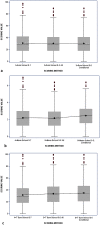An evaluation of the EASY instrument in a cross-sectional study
- PMID: 38341555
- PMCID: PMC10858585
- DOI: 10.1186/s12874-024-02158-w
An evaluation of the EASY instrument in a cross-sectional study
Abstract
Background: The purpose of this paper is to evaluate the impact of modifying the published scoring system to address identified potential weaknesses in the published scoring system for the Evaluation of Activity Surveys in Youth (EASY). A secondary purpose was to evaluate the EASY on children in Grades 1-5. The EASY is a self-report physical activity instrument for youth.
Methods: Original EASY survey results were collected at one time point from an online panel from participants across the United States as part of a larger cross-sectional University of Minnesota project looking at children's specific activity and sports participation between June and August 2019. Data was evaluated using three common scoring methods: simple summation, mean, and transformed summation. Data was compared by Grades 1-5 and 6-8.
Results: The summary statistics of the scores show that there is no statistically significant difference across the scoring methods by population. A paired t-test evaluation of the different scoring methods shows that while the scores are very similar within methodology (simple summation, mean, transformed sum) they are all statistically significantly different from one another, which demonstrates that for any given individual the specific scoring methodology used can result in meaningful differences. The transformed sum provided the strongest methodologic result. Analysis also concluded that administering the scale by proxy to children from grades 1-5 resulted in similar responses to those in Grades 6-8 broadening the appropriate populations able to use this scale.
Conclusion: The transformed sum is the preferred scoring method.
Trial registration: Not applicable.
Keywords: EASY; Evaluation of activity surveys in youth; Physical activity; Scoring methodology; Survey; Youth.
© 2024. The Author(s).
Conflict of interest statement
Competing interests. The authors declare no competing interests.
Figures




References
-
- Saxena S, Van Ommeren M, Tang KC, Armstrong TP. Mental health benefits of physical activity. J Mental Health. 2005;14(15):445–51. doi: 10.1080/09638230500270776. - DOI
-
- U.S. Department of Health and Human Services. Physical Activity Guidelines for Americans. (2nd ed). Washington, DC; 2018.

